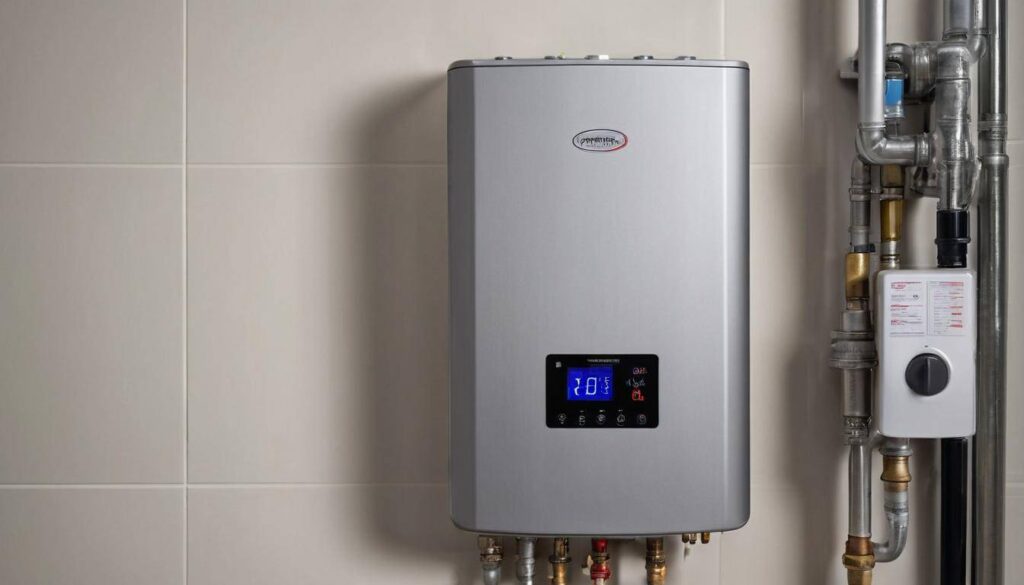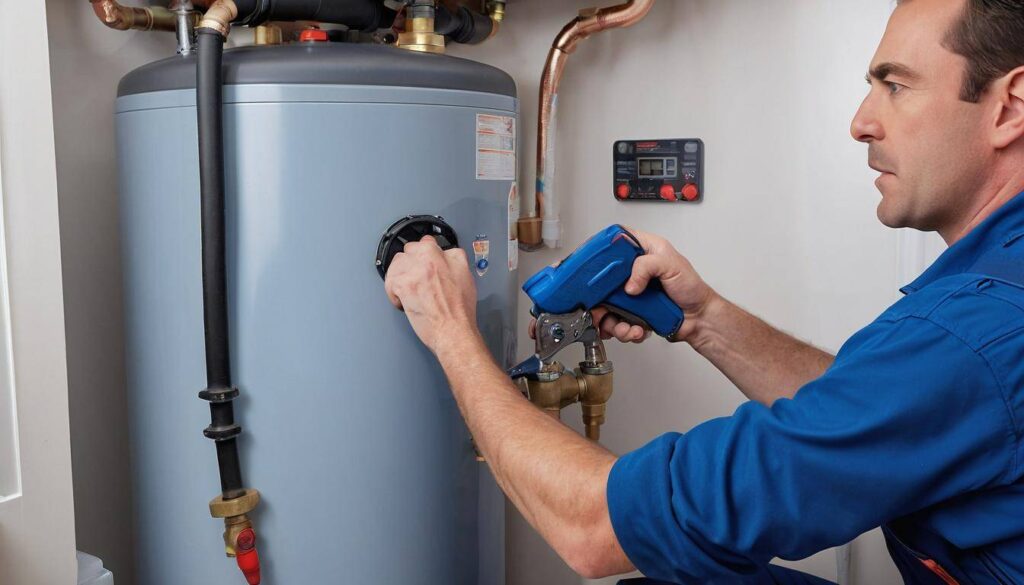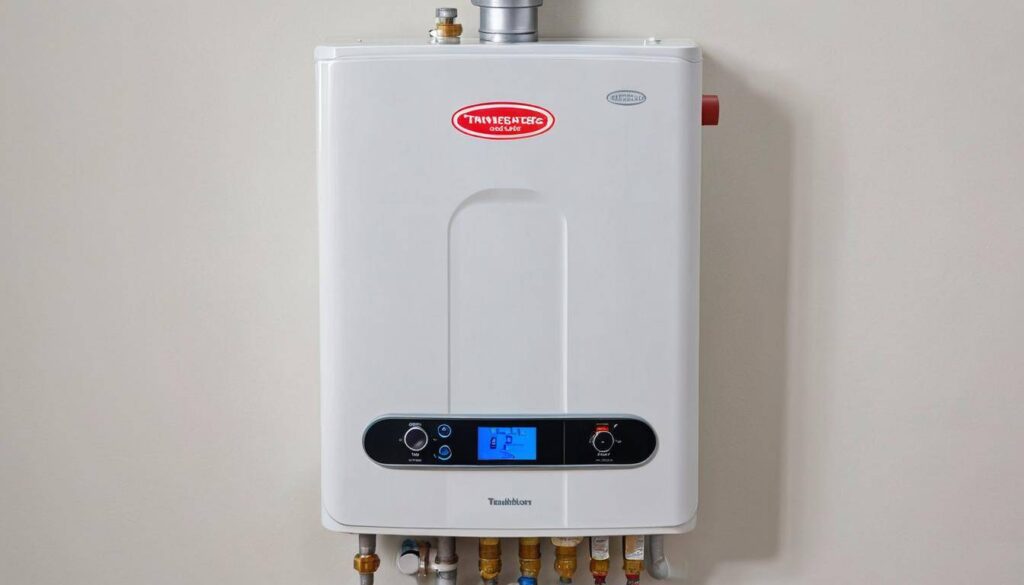Dishwasher Leaking from the Bottom? Here’s How to Troubleshoot and Repair It
A dishwasher leaking from the bottom often signals a problem within its internal components. In such cases, checking if the appliance is level or inspecting the door gasket for any wear and tear becomes essential. However, note that leaks could also originate from the pump or hoses – an aspect many tend to overlook initially. Now, let’s dive in to understand how we can assess this leakage issue. A common cause of a dishwasher leaking from the bottom is a damaged door gasket or a faulty water inlet valve. To address this issue, try replacing the door gasket and inspecting the water inlet valve for any signs of damage or obstruction. If the problem persists, it’s best to seek professional assistance from a licensed plumber to diagnose and resolve the issue effectively.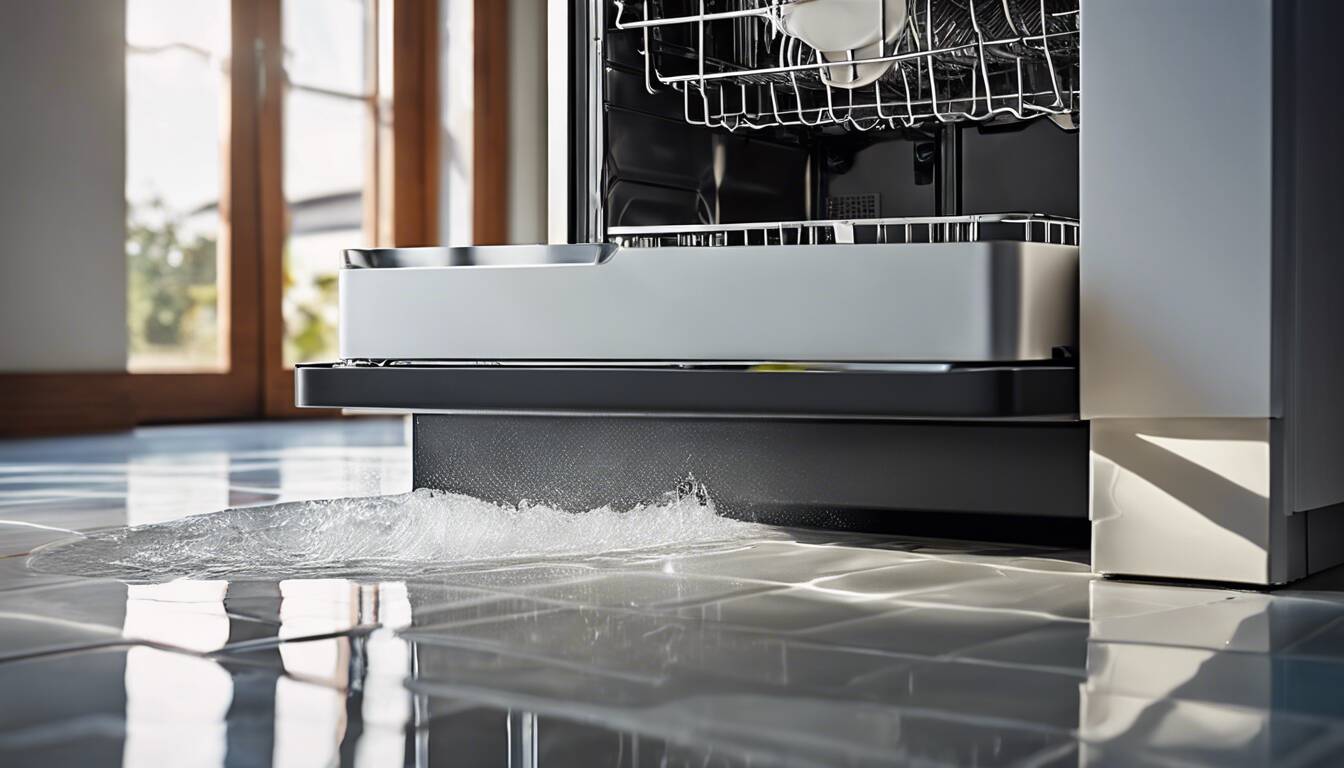
Assess the Leakage Issue
When handling a dishwasher leak, it’s crucial to be thorough in your initial assessment. Remember, these appliances may seem complicated, but often the cause of a leakage is quite simple.
First, let’s talk about leveling. Dishwashers need to be level for them to work properly. If your dishwasher isn’t properly leveled, it may lead to leaks. Check if it’s sitting flat on the floor and make adjustments if necessary. Sometimes just a slight tweak in its position can make all the difference.
Next up is the door gasket. It’s a rubbery lining that seals the door closed when you start a wash cycle. If this gasket gets torn or wears down over time from daily use, water could start to leak out. Take a close look at it and if you see any tears or gaps, that might be the cause of your problem.
Imagine looking for visible leaks as if you were solving a puzzle. Any visible puddles or wet spots around the bottom of your dishwasher are helpful clues. Even better, run your fingers under hoses and around pump seals to feel for any moisture.
Look closely and take note of any odors too – sometimes trapped food particles can lead to clogs and odd smells, potentially causing the overflow.Remember, inspecting a potential leak is like trying to find why your favorite watering can is dripping on that sunny day in your garden – you have to go through each part meticulously to find where the spill is coming from. By carefully examining these areas, you are essentially trying to triangulate the source of your problem. Knowing what you’re dealing with will help guide you toward making an informed decision about repairs or replacements. This initial assessment sets the stage for taking specific corrective actions tailored to your dishwasher’s unique issue. Having laid a solid foundation by identifying potential leak sources, our next step involves initiating targeted repairs specific to these issues in order to achieve long-term savings of both time and money.
Steps to Troubleshoot Dishwasher Problems
Troubleshooting dishwasher problems doesn’t have to be a daunting task. With the right approach, you can often diagnose and even repair issues on your own without needing to call in a professional. Here are some systematic steps you can take to identify and resolve common problems.
1. Check the Door Gasket
The first step in troubleshooting a leaking dishwasher is to examine the door gasket thoroughly for any signs of damage or wear such as cracks, tears, or deformities. A damaged door gasket can allow water to escape during the wash cycle. Fortunately, replacing it is a relatively straightforward repair that can often resolve leakage issues. Remember: A faulty door gasket is a common cause of leaks and can be replaced to resolve the issue. A door gasket is an essential component that prevents water from seeping out of your dishwasher as it cleans your dishes. Over time, wear and tear may lead to degradation of the gasket, resulting in leaks. By regularly inspecting and promptly replacing a worn-out gasket, you can prevent water damage and maintain the optimal performance of your dishwasher.2. Examine the Drain Hose
An obstructed or faulty drain hose can also be a culprit behind dishwasher leaks. Start by ensuring that the drain hose isn’t kinked or damaged, which could impede proper drainage during the wash and rinse cycles. If issues are found, cleaning out clogs or replacing damaged sections can help alleviate leakage problems. Keep in mind: Ensure that the drain hose is not kinked, clogged, or damaged, as these issues can lead to water leakage during the dishwasher’s operation. The drain hose is responsible for carrying waste water out of the dishwasher after each cycle. Regularly inspecting and maintaining it is essential to prevent potential issues and keep your dishwasher operating smoothly.3. Level the Dishwasher
The stability and alignment of your dishwasher play a crucial role in preventing leaks. An unevenly positioned dishwasher can cause water to pool and eventually leak out during its operation. Using a standard level, check if your dishwasher is evenly aligned on the floor. If not, adjusting the feet at the bottom of the dishwasher can ensure proper alignment and reduce the risk of leaks. Pro tip: Use a level to check if the dishwasher is evenly aligned on the floor. Ensuring that your dishwasher is level not only prevents leaks but also promotes efficient drainage within the appliance, thereby avoiding potential water damage caused by unstable positioning.4. Inspect the Tub
Carefully examine both the interior tub and areas around the door edges for any signs of cracks or damage as they can lead to significant leakage issues during the wash cycle. Identifying and addressing these concerns early can help prevent further damage and maintain efficient operation. A thorough inspection of the dishwasher’s tub is essential to identify potential sources of leaks. It enables you to proactively address any damage before it leads to more significant problems down the line. By following these troubleshooting steps, you can methodically identify potential causes of dishwasher leaks and take appropriate measures to resolve them effectively—proactively maintaining your appliance extends its lifespan while preventing costly repairs in the future. In addressing potential causes for dishwasher leaks, it’s also important to consider proactive measures that minimize future damage due to maintenance neglect- moving from diagnosing trouble spots to preventing further ones.Cleaning to Prevent Further Damage
When a dishwasher begins leaking from the bottom, it often signals that something is clogging or inhibiting its regular functions. Regular cleaning is pivotal to prevent such issues in the future. It’s akin to maintaining the health of your dishwasher; just as we need to eat right and exercise regularly to stay healthy, our dishwasher requires cleaning and upkeep to function at its best.
Regular cleaning goes beyond keeping your dishwasher looking clean; it’s about preventing clogs and blockages that could lead to water overflow and leaks. Imagine a garden hose. If you let dirt and debris build up inside it without regular cleaning, the water won’t flow smoothly, leading to unexpected bursts, similar to what happens in a dishwasher.
Importance of Regular Cleaning
Cleaning the interior, filter, and spray arms of the dishwasher removes accumulated food particles, grease, or soap scum that might contribute to clogs. This proactive cleaning routine can save you time and money by preventing leaks that result in further repairs or replacements. As a general rule of thumb: if water isn’t flowing easily through your dishwasher during a wash cycle, check for clogs and consider preventative cleaning. Similar to clearing drains at home when they get clogged with hair and debris, dishwashers need the same care. Food particles often get trapped in the filter and spray arms—similar to how hair gets stuck in our sink pipes—leading to unexpected water leaks from the bottom. Without proper cleaning, mold might also start growing in these concealed spaces within the dishwasher, resulting in unpleasant odors and potential damage not only to the appliance but also your home’s indoor air quality.Using White Vinegar and Baking Soda for Cleaning
If you’re pondering over how to clean these components effectively without using harsh chemicals, a mixture of white vinegar and baking soda can be your go-to solution. This natural combination helps break down mineral deposits, mold growth, and helps maintain proper drainage in the dishwasher. To use this mixture effectively:- Start by sprinkling about half a cup of baking soda on the bottom of the dishwasher.
- Then pour two cups of white vinegar into a bowl or cup and place it on the top rack of the empty dishwasher.
- Run a hot water cycle. The combination of baking soda and vinegar will provide gentle scrubbing action inside while deodorizing your dishwasher.
Common Dishwasher Faults Leading to Leakage
Dishwashers are exceptional appliances, but they are not immune to problems. Even with proper cleaning and care, various faults can lead to leaks. Let’s delve into some of these issues and what causes them.
Worn Out Door Gasket
One of the most common reasons for dishwasher leakage is a worn-out door gasket. The door gasket creates a water-tight seal when the dishwasher is closed. Over time, this rubber or vinyl seal can degrade, crack, or lose elasticity. When this happens, water can seep out of the dishwasher during its operation. Statistics reveal that more than 50% of dishwasher leaks are due to deteriorated door gaskets. This highlights the importance of regularly checking and replacing this crucial component. Quick tip: You can inspect the door gasket for signs of wear by running your finger along the edge while feeling for any cracks or splits. Additionally, visually inspect it for any visible damage or distortion.Defective Tub
Another potential cause of leaks is having cracks, chips, or warps in the dishwasher’s tub. These defects compromise the tub’s ability to contain water during the washing and rinsing cycles, leading to water escaping onto the floor. These defects are often the result of mishandling heavy dishware or using overly abrasive cleaning materials – continual exposure to high temperatures may also contribute to these tub malfunctions. Recommendation: When loading dishes, be mindful of how you place heavy items and avoid overcrowding the tub to prevent unnecessary pressure that could lead to chips and cracks.Clogged Drain
A clogged drain or filter in your dishwasher can also be a culprit for causing leaks. When blockages occur, they impede proper drainage during the dishwashing cycle, leading to water backing up inside the machine and ultimately leaking onto the floor. For instance, food particles and debris can accumulate in the drain and filter over time, obstructing the water flow. This is often exacerbated by inadequate pre-rinsing before placing dishes in the machine. To mitigate this issue, it’s essential to routinely inspect and clean the dishwasher’s drain and filter according to the manufacturer’s guidelines. Additionally, ensuring that dishes are adequately rinsed before loading will help prevent debris from accumulating in these crucial areas. By understanding these common dishwasher faults leading to leakage, you’re now equipped with valuable knowledge that will aid in troubleshooting and addressing potential issues with your appliance. Armed with a greater understanding of common dishwasher leaks, let’s now move on to address faulty seals and clogged hoses.Addressing Faulty Seals and Clogged Hoses
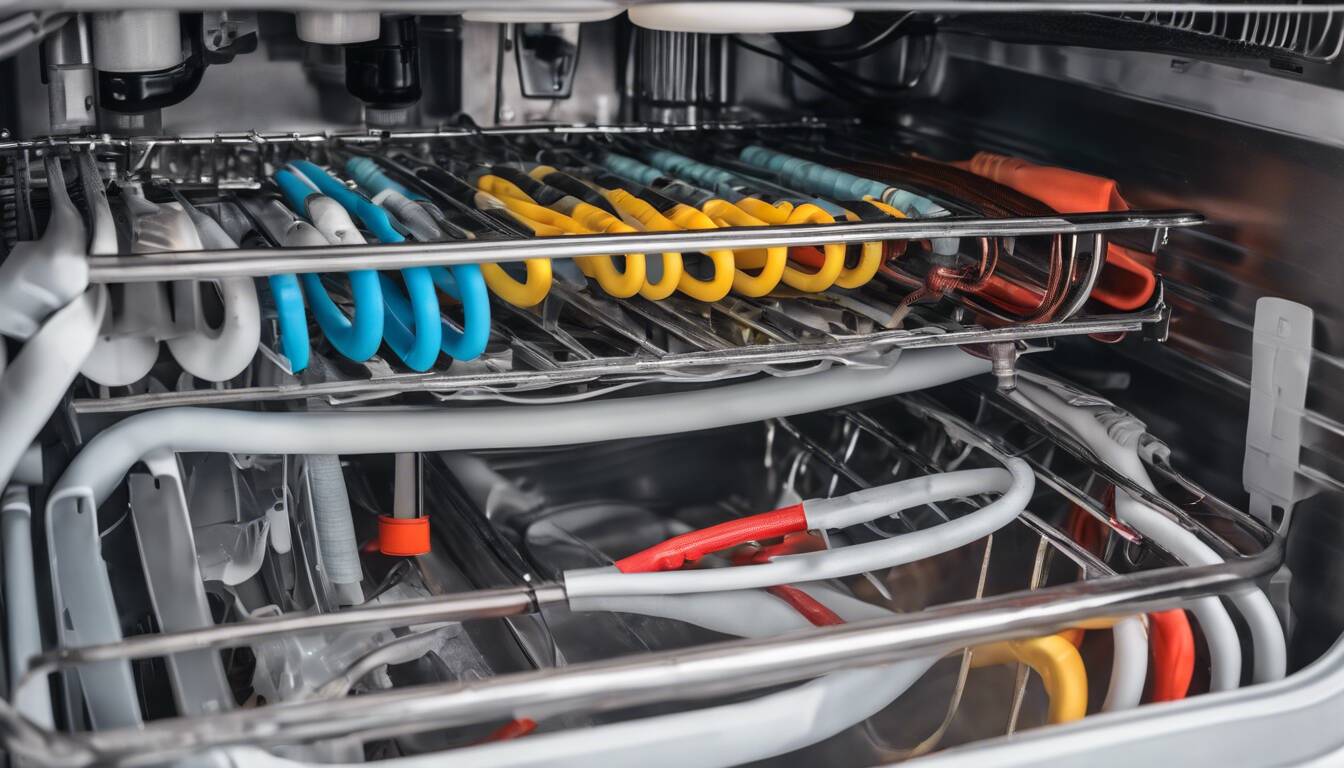 When it comes to leaky dishwashers, worn-out door gaskets and seals are usual suspects. The gasket is a flexible rubber or vinyl seal that runs around the perimeter of the dishwasher door. It creates a watertight closure when the dishwasher door is latched shut during a wash cycle.
Over time, these seals can dry out, become brittle, or get caked with soap residue and dirt, leading them to lose their effectiveness. A compromised seal can result in water seeping through the gap and leaking onto your kitchen floor. Examining the gasket for signs of wear such as cracks, tears, or hardness is crucial. If any of these signs are present, it’s time to replace the gasket.
In addition to this, ensuring the cleanliness and proper installation of the drain hose is essential. The drain hose is responsible for carrying waste water from the dishwasher to the sink’s drainage system.
Sometimes, debris can accumulate within the drain hose over time, obstructing the flow of water and causing backups that result in leaks. Inspect the drain hose for any clogs and remove any buildup to allow unobstructed water drainage. Also, verify that the connection between the dishwasher and sink’s drainage system is secure and free from any kinks or bends that could impede water flow.
Think of it this way: Just like how a kink in a garden hose slows down or blocks water flow, a kink or obstruction in the dishwasher drain hose can lead to water backup and leakage.
By taking proactive measures to ensure that door gaskets and seals are in good condition and that drain hoses are clear from debris and well-connected, you can significantly reduce the likelihood of water leaks from your dishwasher.
Being meticulous about maintaining your dishwasher may stave off potential problems, but some issues are best left in the hands of professionals. Let’s move on to explore these scenarios.
When it comes to leaky dishwashers, worn-out door gaskets and seals are usual suspects. The gasket is a flexible rubber or vinyl seal that runs around the perimeter of the dishwasher door. It creates a watertight closure when the dishwasher door is latched shut during a wash cycle.
Over time, these seals can dry out, become brittle, or get caked with soap residue and dirt, leading them to lose their effectiveness. A compromised seal can result in water seeping through the gap and leaking onto your kitchen floor. Examining the gasket for signs of wear such as cracks, tears, or hardness is crucial. If any of these signs are present, it’s time to replace the gasket.
In addition to this, ensuring the cleanliness and proper installation of the drain hose is essential. The drain hose is responsible for carrying waste water from the dishwasher to the sink’s drainage system.
Sometimes, debris can accumulate within the drain hose over time, obstructing the flow of water and causing backups that result in leaks. Inspect the drain hose for any clogs and remove any buildup to allow unobstructed water drainage. Also, verify that the connection between the dishwasher and sink’s drainage system is secure and free from any kinks or bends that could impede water flow.
Think of it this way: Just like how a kink in a garden hose slows down or blocks water flow, a kink or obstruction in the dishwasher drain hose can lead to water backup and leakage.
By taking proactive measures to ensure that door gaskets and seals are in good condition and that drain hoses are clear from debris and well-connected, you can significantly reduce the likelihood of water leaks from your dishwasher.
Being meticulous about maintaining your dishwasher may stave off potential problems, but some issues are best left in the hands of professionals. Let’s move on to explore these scenarios.
When to Seek Professional Assistance
At some point, DIY troubleshooting might not suffice. If after checking and cleaning the seals, hoses, and conducting preventive maintenance, you still notice water pooling on your floor, the issue may go beyond surface level troubles.
It’s alright to seek help when matters become too intricate. Licensed professionals like plumbers or appliance repair technicians are trained to diagnose and resolve complex issues—it’s their area of expertise! They possess the equipment, training, and expertise to address problems that surpass simple maintenance steps.
This is particularly paramount in the case of mechanical or electrical faults. Addressing such intricacies requires in-depth knowledge of how machines operate, including their various components and electrical connections. A licensed technician can precisely identify issues in the electrical circuitry or mechanical parts such as pumps, valves, or sensors.
In some instances, access to specific parts of the dishwasher may be physically challenging. Licensed professionals are versed in appliance navigation and can disassemble your dishwasher safely without causing any damage—and most importantly, reassemble it properly.
For instance, consider a scenario where a defect occurs with the water inlet valve of your dishwasher. This component allows water into your appliance, and if it’s broken, leaks could transpire. A professional would accurately assess this issue and efficiently replace the faulty part.
Moreover, seeking professional assistance ensures that any potential water wastage is promptly minimized. Leaky dishwashers can escalate water waste, leading to higher utility bills and causing significant harm to the environment. Swift resolution isn’t just about maintaining your appliance—it’s about acting responsibly toward precious resources as well.
If you’ve found yourself needing professional assistance for your dishwasher in Calgary, you’re in luck. My Calgary Plumber offers specialized services catering to all your plumbing needs.

